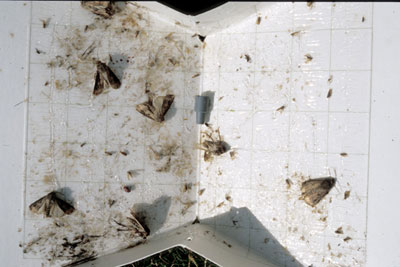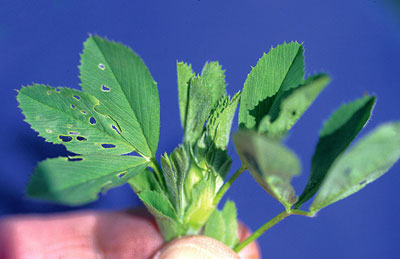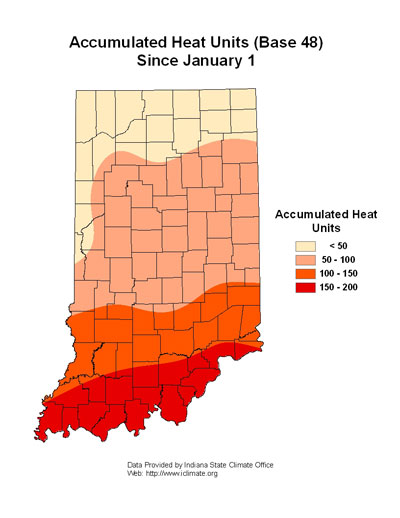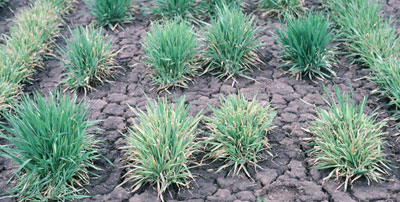Pest & Crop Newsletter, Entomology Extension, Purdue University
- Black Cutworm Spring Arrival Met With Hostile Welcoming
- Bt-Rootworm Corn and Protecting Refuge Acres from Damage
- Alfalfa Weevil Scouting Should Begin in Extreme Southern Indiana
- Black Cutworm Adult Pheromone Trap Report
- General Information on the Crop Diagnostic Training and Research Center
- 2008 Popcorn Agri-Chemical Handbook Now Available
Black Cutworm Spring Arrival Met With Hostile Welcoming – (John Obermeyer and Larry Bledsoe)
- Black cutworm moths arrived before recent freezing nights.
- Exposed moths/eggs likely died during cold snap.
- Moth arrival has just begun.
- Timing of scouting can be improved by tracking heat unit accumulations.
- Donít rely on insecticide-treated seed to prevent economic damage.
Many of our pheromone trapping cooperators throughout the state captured black cutworm moths before the recent freezing temperatures - refer to the “Black Cutworm Adult Pheromone Trap Report” for details. This was attributed to massive storm front from the southwestern portions of the country late last week. However, the majority of those early arrivals and any eggs laid have likely perished; being a southern migrant they aren’t cold-hardy as our overwintering species (e.g., variegated cutworm). This is good news, although more moths are soon to arrive.
Pheromone trap bottom with captured black cutworm moths
Moth arrival, along with the use of heat units to predict the beginning of larval activity, gives us an indication of potential severity of the problem and locations of concern. Thus, we are able to predict with some degree of accuracy when and where crop damage is likely to occur based on these data. We will track heat unit accumulations and predicted damage for your area in future issues of the Pest&Crop.
Because of the sporadic outbreak nature of this pest, the tried, true, and economic approach to black cutworm management is to scout cornfields, determine infestation and damage levels, and use a rescue treatment, if needed. Producers using insecticide-treated seed may have a false sense of security concerning black cutworm control. Certainly the systemic activity of these newer insecticides during the seedling stage should help suppress small larvae feeding on plants. However, this protection is short-lived and fields attracting egg-laying moths during multiple flights will likely experience significant damage and stand losses. During periods of cool temperatures and slow seedling growth uptake of the insecticide may be negligible, leaving the plant vulnerable to attack.
![]()
Bt-Rootworm Corn and Protecting Refuge Acres from Damage – (John Obermeyer and Larry Bledsoe)
- Planting of refuge with Bt-Rootworm corn is necessary and crucial to prevent resistance.
- Misinformation and creativity abound concerning refuge acres.
- Refuge strips throughout a field best facilitate intermixing of beetle populations.
- Protecting refuge acres from rootworm feeding can be a challenge, especially in high-risk rootworm damage areas.
Bt-Rootworm corn’s popularity and use continues to increase. Hopefully all who are planting this technology understand and will implement EPA’s mandated refuge. This is important for 2 reasons: First, it is the law. Second, not using refuges could have disastrous consequences in the long-term for growers, due to insect resistance. The refuge is crucial to preserve the longevity of this technology. There are few guarantees in agriculture, but one is that insects will always evolve and adapt to counteract whatever we throw at them. The other guarantee is that once resistance occurs, it will be on commercial farms, not in research plots or laboratories.
The refuge must comprise 20% of the production field where Bt corn is used. The 80/20 arrangement of the field is quite flexible, but using the neighbor’s corn as a refuge is NOT. Options include planting the refuge in blocks, strips throughout, or end rows all are acceptable as long as it equals or exceeds 20% of the field’s total acreage. The idea behind each of these arrangements is that beetles emerging from Bt-Rootworm corn (yes, there are survivors) will mate with beetles from the refuge. Two years of our refuge design research shows that striping the refuge within the field better mixes the emerging beetle populations, potentially delaying insect resistance.
Protecting refuge corn from rootworm feeding has presented some challenges for producers. They have shared a wide range of thoughts on this from providing no protection for the refuge, to mixing Bt and refuge seed in the seed boxes, and mounting insecticide boxes that may or may not be approved by the equipment manufacturer. In moderate to high-risk rootworm areas, 20% of a field is worth protecting from the rootworm’s potentially devastating damage. Mixing Bt and refuge seed (“refuge-in-the-bag”) is not allowed or recommended at the present time. Since the refuge seed will have no protection, and eggs will be distributed throughout the field, the 20% unprotected seed will be subject to high pressure and damage.
Therefore we are left with planting and protecting the refuge separately from the rest of the field. This entails using granular, liquid or seed-applied insecticides. The newer John Deere planters have eliminated granular insecticide units, although they can be “plumbed” for liquid soil insecticides. Some of these planters have been successfully retrofitted with SmartBox® systems that fall within the manufacturer’s weight tolerances. Splitting the planter with Cruiser Rootworm or Poncho 1250 seed-applied insecticides is possible with planters that have row seed boxes, but may not be possible with bulk seed boxes. Also, it should be mentioned that low rates of the seed-applied insecticides (Poncho 250, for example) do NOT control rootworms. Rootworm product efficacy should be considered depending of the anticipated risk to damage. In general, liquid soil insecticides and seed-applied insecticides perform poorly under high rootworm pressure. Granular insecticides are still the best bet to protect a refuge that is under high pressure.
Should the refuge remain untreated at planting time and damage is anticipated or noticed, rescue treatments are still a possibility. Liquid insecticides (i.e., Furadan, Lorsban) can be applied at post-emergence or cultivation-time. Obviously planting the refuge in a block design that is well marked will help in treating the unprotected corn. Shortly before rootworm egg-hatch, about the third week of May, drop nozzles should be directed toward the base of the corn plants with the labeled rate of insecticide. Following-up with cultivation will incorporate the insecticide and promote the establishment of brace roots. Weather is often a limiting factor in getting postemergence insecticides applied in a timely manner.
![]()
Alfalfa Weevil Scouting Should Begin in Extreme Southern Indiana - (John Obermeyer and Larry Bledsoe)
Field scouting for alfalfa weevil damage should begin when approximately 200 heat units, base 48°F, have accumulated from January 1 (see accompanying map). Sampling a field to determine the extent of alfalfa weevil damage and average stage of weevil development is best accomplished by walking through the field in an “M-shaped pattern.” Ten alfalfa stems should be examined in each of 5 representative areas of the field for a total of 50 stems from the entire field. Consider that south facing slopes and/or sandy soils warm sooner and should be included in the sampling. Each stem should be examined for: (1) evidence of tip feeding by alfalfa weevil larvae; (2) maturity of the stem, i.e. pre-bud, bud and/or flowers; and (3) stem length. The average size (length) of weevil larvae should also be noted. Although large alfalfa weevil larvae are relatively easy to find, small larvae are difficult to see; thus, very close examination of leaves may be required to detect “pin-hole” feeding, small black fecal pellets and small off-white larvae.
Early, “pin-hole,” alfalfa weevil feeding
![]()
Click here to view the Black Cutworm Pheromone Trap Report
Soilborne Viruses of Wheat - (Gregory Shaner)
- Widely fluctuating temperatures bring on symptoms.
Two soilborne viruses infect wheat in Indiana: Soilborne wheat mosaic virus (SBWMV) and Wheat spindle streak mosaic virus (WSSMV). From a distance, fields or parts of fields are pale green or yellow, as though they are deficient in nitrogen. Closer inspection of plants reveals a mosaic symptom on leaves--narrow, pale green to yellow, wavy-margined streaks on the leaf blade. The streaks induced by WSSMV infection tend to be longer than streaks induced by SBWMV, and taper at both ends, hence the name “spindle.” In practice, it is impossible to distinguish symptoms of the two viruses visually. Both viruses may be found in the same field, and both viruses may infect a single plant. WSSMV tends to be more uniformly distributed throughout fields than is SBWMV.
The viruses persist in a common soilborne microorganism, Polymyxa graminis. Polymyxa infects wheat roots in the fall. This infection is of little consequence itself, but it allows transmission of the viruses to the plant. Wetter areas of fields may show more intense symptoms because Polymyxa prefers moist conditions. Rains that fell during late September and again during late October may have been sufficient for infection in some fields. Although infection occurs in the autumn, symptoms of virus infection don’t appear until the following spring. The timing of symptom development depends on weather. Intermittent periods of warm and cold weather favor symptom development. Recent wide fluctuations in temperature may trigger symptom development as temperatures rise again.
Most varieties of soft red winter wheat grown in Indiana have some degree of resistance to these viruses. They may show some yellowing during periods of fluctuating temperatures during the spring, but once the cold weather is past, these varieties tend to outgrow the symptoms on lower leaves and there is probably little damage. A few varieties are more susceptible. The intensity of yellowing is greater, and is accompanied by stunting, reduced tillering, and death of some plants. These varieties will suffer economic damage from these diseases. Some varieties show a rosette symptom when infected by SBWMV. They produce numerous, stunted tillers. There is no remedial action that can be taken at this stage. If a variety develops severe symptoms, don’t plant it again next year. There are plenty of varieties with good resistance.
Differences in resistance to WSSMV and SBWMV. The variety in the lower left and the variety in the upper right are highly resistant. The three varieties in starting at the right-hand side of the front row are susceptible. They are pale green and stunted. This degree of damage early in the season would probably result in some loss of yield.
Severe mosaic on a susceptible variety of wheat. Either virus, or both, could produce these symptoms.
Winter Wheat Condition in Indiana – (Herb Ohm) - Wheat in general came through the winter in good condition. Most damage was in low to even slightly low areas in some fields – even a few inches lower than surrounding areas in the field made a big difference in many fields.
Should I keep or destroy my wheat? One should wait until mid April to make that decision, especially in the northern ½ of Indiana, because it is early to seed other crops like corn and especially soybeans. Given the cool and wet conditions this spring, wheat is just beginning to grow in the northern ½ of the state, and one can much more accurately determine the wheat stand density after it is growing well. Given the more-than-usual wheat growth last fall, if the leaves are frozen severely, the plant might look dead, but the crown might actually be OK. Generally, if there are at least 15 plants per square foot, it is worth keeping – there will be a yield loss, but with current prices it should be worth keeping, although one should plan on applying a herbicide.
![]()
Corn Planting Date is Important, But.... – (Bob Nielsen)
- Early planting favors higher yields, but does not guarantee higher yields.
- Statewide averages for planting date and yield are not strongly related.
- Planting date is but one of many yield influencing factors.
Conventional wisdom says that the prime planting window for maximum corn yields in much of Indiana opens about April 20 and closes about May 10. This “window”’ typically opens about one week later across the northern tier of Indiana counties (cooler conditions) and about one week earlier across the southern tier of Indiana counties (warmer conditions).
Very little corn, if any, has been planted in Indiana to date. By itself, this is not much cause for concern because typically only a very small percentage of acres are ever planted by this date in Indiana. However, the specter of delayed planting is clearly on the horizon because little other spring fieldwork has been completed due to the frequent and sometimes excessive rainfall in recent weeks. For many growers, tillage operations, herbicide applications, and nitrogen fertilizer applications must be completed first before they can consider planting their crops.
What are the consequences of a delayed start to planting? How important a predictor of statewide corn yield is planting date anyway? Does late planting in and of itself guarantee lower than normal yields? Interestingly, the planting date effect on statewide average corn yield is not clearcut.
If one reviews USDA-NASS crop progress reports for the past 17 years (USDA-NASS, 2008), there is NOT a strong relationship between planting date and yield on a statewide basis. Specifically, departures from annual trend yield are not strongly related to corn planting progress. Figures 1 through 3 illustrate this relationship for three measures of planting progress; percent acres planted by April 30, percent acres planted by May 15, and percent acres planted by May 31. Even though one can technically define a linear relationship between departure from trend yield and planting progress by April 30 or May 15, the relationship only accounts for about 24% of the variability in yield departure year to year (Fig’s 1 & 2). In other words, a number of yield influencing factors (YIFs) other than planting date affect the ultimate maximum yield for a given year.
So what’s the deal? Why is it that every corn agronomist known to man preaches about the importance of timely planting and yet the statewide statistical data suggest that planting date accounts for only 24% of the variability in statewide yields from year to year? Let’s think more closely about this seeming paradox.
It is true that corn grain yield potential does indeed decline with delayed planting after about May 1 (Nafziger, 2008). The yield loss per day varies from about 1 bu/ac/day early in May to nearly 2 bu/ac/day by the end of May. Yield potential decreases with delayed planting because of a number of factors, including a shorter growing season, insect & disease pressure, and moisture stress during pollination.
However, the good news is that planting date is but one of many YIFs for corn. What is important to understand is that yield loss to delayed planting is relative to the maximum yield possible in a given year. In other words, if all the other YIFs work together to determine that the maximum possible yield this year is 200 bu/ac, then the consequence of a 10-day planting delay beyond May 1 (at 1 bu/ac/day) would be a yield potential of 190 bu/ac (i.e., 200 bu/ac potential minus 10 bu/ac due to delayed planting). However, if all the other YIFs work together to determine that the maximum possible yield this year is only 160 bu/ac, then the consequence of a 10-day planting delay beyond May 1 (at 1 bu/ac/day) would be a yield potential of 150 bu/ac (i.e., 160 bu/ac potential minus 10 bu/ac due to delayed planting). Make sense?
Consequently, it is possible for early-planted corn in one year to yield more than, less than, or equal to later-planted corn in another year depending on the exact mix of YIFs for each year. That is the reason why statewide average corn grain yields frequently vary by plus or minus 10% from the expected trend yield from year to year.
For example, the crop years 1997 and 1993 represent early and late planting dates in Indiana (Fig. 2). About 80% of the state’s crop was planted by May 15 in 1997, but only 46% of the crop was planted by May 15 of 1993. Yet, the earlier planted 1997 crop yielded 8.3% BELOW trend yield for that year and the later planted 1993 crop yielded 3.4% ABOVE trend yield. Why? Important differences in YIFs between the years other than simply planting date.
Bottom Line
Let’s not succumb quite yet to fearmongering triggered by the prospects of a delayed start to corn planting in 2008. “Mudding in” a crop early to avoid planting late will almost always end up being an unwise decision. While important, planting date is only one of many yield-influencing factors for corn.
Another reason that it is probably too early to fearmonger about the anticipated late start to planting is that growers have the machinery capacity to “catch up” quickly once the weather and soil conditions become favorable for planting. The 1992 planting season began as one of the slowest (Fig. 1) but quickly recovered within two weeks to a respectable pace (Fig. 2) and finished the season with the largest POSITIVE departure from trend yield in the past 17 years. We also know from past years’ experiences that, on average, 50% of the state’s corn crop is typically planted over about an 18-day period (Fig. 4). Furthermore, it is not unheard of for growers to plant 45 to 50% of the state’s crop in a single week given good working conditions (Fig. 5).
References
Nafziger, Emerson. 2008. Thinking About Corn Planting Date and Population. The Bulletin (No. 2, Article 7, April 4), Univ. of Illinois Extension. [On-line]. Available at <http://www.ipm.uiuc.edu/bulletin/article.php?id=890>. [URL accessed 4/12/08].
USDA-NASS. 2008. Crop Progress and Condition. USDA, National Agricultural Statistics Service. [On-line]. Available at <http://www.nass.usda.gov/Statistics_by_State/Indiana/Publications/Crop_
Progress_&_Condition/index.asp>. [URL accessed 4/12/08].
For other timely crop management info...
Chat ‘n Chew Cafe: <http://www.kingcorn.org/cafe>
CNN Archives:<http://www.kingcorn.org/news/archive.html>
Fig. 1. Percent departure from trend yield versus percent of corn acres planted by April 30
in Indiana, 1991-2007.
Fig. 2. Percent departure from trend yield versus percent of corn acres planted by May 15
in Indiana, 1991-2007.
Fig. 3. Percent departure from trend yield versus percent of corn acres planted by May 31
in Indiana, 1991-2007.
Fig. 4. Corn planting progress in Indiana during the years 1998 through 2007.
Fig.5. The fastest single week of corn planting progress in Indiana for individual years
from 1991 through 2007.
General Information on the Crop Diagnostic Training and Research Center – (Corey Gerber)
The Purdue University Crop Diagnostic Training and Research Center is known across the Midwest for its unique “hands-on” approach for teaching the art and science of accurately diagnosing agricultural crop problems. The Center, established in 1985, is designed to provide informative topics in a “real world” environment, where agriculturists can sharpen their crop problem trouble-shooting skills and evaluate new and alternative management strategies. The long-term goal of the Center is to provide quality, state-of-the-art training in all aspects of crop production and management.
At this Center, many small plot demonstrations illustrate insect, nematode, weed, disease, soil fertility, and cultural problems associated with corn, soybean, forage, and small grain production. Extension, research, and teaching staff from Purdue University’s departments of Agricultural and Biological Engineering, Agronomy, Botany and Plant Pathology, and Entomology, as well as other leaders in the agricultural community across the U.S., conduct each workshop.
Please visit the Calendar section of this Web site to view workshop dates, agendas, speakers, and the CCH’s & CEU’s available for each workshop.
The Purdue University (West Lafayette) Crop Diagnostic Training Center is located on the grounds of the Purdue University Agronomy Center for Research and Education.
For additional information on specific training days, costs, housing, and registration information visit the website: <http://www.agry.purdue.edu/dtc/index.html> or contact:
Corey K. Gerber, Ph.D., Director
Purdue Crop Diagnostic Training and Research Center
Purdue University, Agronomy Department
915 W. State St.
West Lafayette, IN 47907-2054
(765) 496-3755
![]()
2008 Popcorn Agri-Chemical Handbook Now Available – (Genny Bertalmio) - The 2008 Popcorn Agri-Chemical Handbook is now available at <http://www.popcorn.org/handbook> to insure everyone in the popcorn industry is informed about products registered for use on popcorn or in popcorn storage facilities. The handbook lists agri-chemicals registered, special use restrictions, the status of a chemical under special review by the Environmental Protection Agency (EPA) and residue tolerances established by EPA, CODEX and Japan. The Popcorn Board urges you to provide the above link to your growers or download, print and distribute the updated version of this critical information to them. Contact Genny Bertalmio, 312.673.4883 or <gbertalmio@smithbucklin.com>, for further information or if you require a hard copy. The Popcorn Board accepts voluntary contributions to insure continued funding of its efforts to provide this important information to the popcorn industry. Checks should be mailed to the Popcorn Board, 401 N. Michigan Avenue, Chicago, IL 60611-4267. Thank you. <http://www.popcorn.org/>












